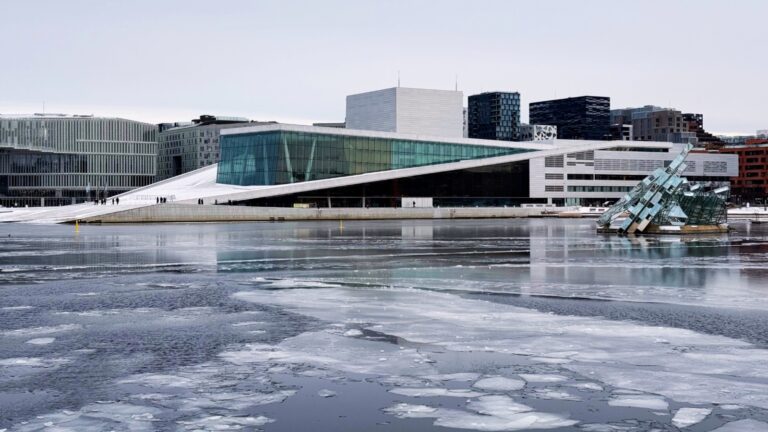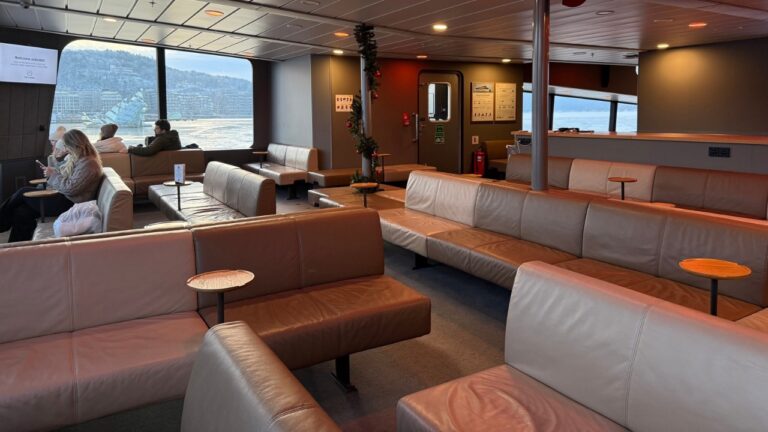From experiencing silent electric ferries to spotting fjord saunas, this Oslo fjord sightseeing cruise introduces visitors to modern Norwegian culture.
It was a crisp January morning and the temperature read -13°C, the icy air seeming to cling to every breath.

I’d planned to take a sightseeing cruise along the Oslofjord—a chance to see many landmarks I knew from a new perspective—but as I stared out at the mist hovering over the islands and the ice crackling along the water’s edge, curling up in my warm hotel room seemed far more appealing.
Still, something tugged at me. Perhaps it was the allure of experiencing the Norwegian love for the outdoors, even in the depths of winter, or maybe the idea of seeing Oslo from the water in this magical, frozen state.
Whatever it was, I booked my ticket online just 45 minutes before departure. It cost NOK 410 for the first departure of the day (10am), with a couple more departures available later in the afternoon.
Oslo Fjord Sightseeing Cruises
Of the several options available, I chose the one operated by The Fjords. Their electric ferries had left an impression on me during a recent trip to Flåm, where they glide silently through the fjords like something from the future.

Also, this cruise departed from near the Opera House, a short walk from my hotel, rather than the more crowded Aker Brygge pier. That was definitely a consideration given the cold weather!
Several other options are available from the Aker Brygge area, including trips on historic vessels. There’s no “best” option, so check out all the providers to pick the one that’s right for you.
A Walk Along “Sauna Alley”
After bundling myself up and ensuring my phone was fully charged—essential for filming this trip for a future YouTube video—I set off from my room at the Radisson Blu Oslo Plaza, heading towards the Opera House.
From the promenade, I spotted the ferry docked on the opposite side of the harbour. Making my way around the water’s edge, I stumbled upon a delightful surprise: Oslo’s latest cultural trend—the fjord saunas.
These complexes have become a hallmark of the area in recent years, offering a quintessentially Nordic experience at the very heart of Oslo.

Visitors can take an invigorating dip in the icy waters of the fjord, followed by a rejuvenating warm-up in the sauna—a perfect blend of tradition and modern wellness. Some of them are even boats and can often be seen farther out in the Oslofjord.
As I wandered past the various rafts, my mind suddenly recalled this 2024 incident when a car plunged into the frozen water, and its occupants were rescued by one of the floating saunas.
Although I saw a few people using the saunas, I didn’t see anyone in the water on this extremely cold day. Have you ever taken a fjord sauna in Oslo? Let me know in the comments!
Exploring the ‘Vision of the Fjords’
Boarding the Vision of the Fjords was remarkably quick and seamless. A simple scan of the ticket on my phone, and I was on board. My first impression? Quiet—eerily quiet!

With only about 25 passengers on a vessel designed to comfortably accommodate ten times that number (the official capacity is around 400), it was clear I was in for a spacious and tranquil journey.
The interior design is reminiscent of a fjord ferry, but it has more spacious seating areas, including lounges on two internal decks. You’ll find a small cafe serving hot and cold drinks and snacks including chocolate, crisps, and pølser (Norwegian hot dogs).

What I loved most about the vessel is the outdoor areas. With a design remiscent of the Opera House, guests can walk outside from the main deck and then up the sloping sides of the vessel, all the way to the top.
This very Scandinavian design provides a huge amount of outdoor space all around the vessel. The large windows letting people enjoy the scenery from the comfort of the lounges are also a big plus.

Although I didn’t spend huge amounts of time outside, I did keep popping in and out when there was something I wanted to see and/or film. The design of the ship meant it was quick and easy to get where I wanted to be.
The Electric Ferry Experience
Having experienced electric ferries in Norway before—they’re practically unavoidable these days—I thought I knew what to expect. But as a sightseeing vessel, Vision of the Fjords offered something special: near-total silence.
Technically a hybrid-electric vessel, the only engine noise I noticed was during the brief moments we pulled away from the harbour. Once the batteries took over, the experience transformed into a peaceful glide across the fjord.
The absence of engine noise allowed the natural sounds of the surroundings to shine—a wonderful way to appreciate the sights. How silent it would feel with 400 people on board is another question entirely, but on this quiet day, it was perfect.

One unique aspect of ‘The Fjords‘ sightseeing experience is the absence of live commentary. Instead, passengers are invited to download an app that provides a free audio tour. For me, this was a welcome innovation, and most of the other passengers seemed content with it as well.
That said, I do wonder how this concept fares during peak season. Would crowded decks mean passengers without headphones playing audio aloud, shattering the atmosphere? Thankfully, on this trip, there was no such disruption.
Oslo Landmarks from the Water
So, what exactly is there to see on a fjord sightseeing cruise in Norway’s capital city? Seeing some of Norway’s major landmarks from the water offers a fresh and captivating perspective, even if you’ve explored them on foot.
The journey began with two of Oslo’s most iconic modern structures fading into the distance: the striking, angular Oslo Opera House and the controversial façade of the Munch Museum. Both looked even more impressive framed by the shimmering fjord.

Next, we approached the historic Akershus Fortress. From this vantage point, its medieval walls and towers truly stood out against the city skyline. This is the best way to appreciate the fortress’s grandeur—rising proudly from its waterfront perch.
As we continued, the former shipyards of Aker Brygge and Tjuvholmen came into view. These bustling waterfront districts are now home to chic promenades, upscale dining, and contemporary art galleries.

We then cruised past the bustling dock for the Color Line ferry to Denmark, a sight that sparked a mental note: I absolutely must try the mini-cruise experience someday! This route is a favourite among Oslo locals and visitors alike.
As we continued, we approached the Bygdøy peninsula, a leafy haven famed for its wealth of museums. The striking triangular silhouette of the Fram Museum came into view, standing out prominently as we sailed past.
Oslofjord Islands and Pleasure Boats
From Bygdøy, we turned out into the fjord and headed towards the islands of the Oslofjord. Here, the number of pleasure boats was a surprise, even in the winter when many of them are moored for the season.
Norway has been a world leading boating nation since Viking times, when Norsemen spread fear and unrest far and wide. According to the tour commentary, there are one million pleasure boats in Norway, which equates to a boat for every sixth person.

I love exploring the islands of the Oslofjord. Having taken the ferries to the islands several times before, it was nice to be able to tour around many of them from the water.
Highlights of the journey included the beach and nature reserve of Hovedøya, the colourful vacation cottages dotting the shores of Lindøya, and Gressholmen, an island with a fascinating history as the former site of Oslo’s seaplane airport.
Landmarks of the Oslofjord
Although I’ve sailed to and from the islands before, there were some highlights of the inner Oslofjord that were new to me, making the trip a worthwhile one.
As we approached Dyna Lighthouse, the sight of its elegant white tower perched on the rocky islet sent me scurrying out onto the deck, braving the sharp winter air.

Built in 1874, its charm and storied history seemed to emanate from every weathered surface, from the fog bell to the keeper’s quarters. With the icy wind biting at my cheeks, I couldn’t help but imagine the resilience of the lighthouse keepers who once called this tiny, windswept outpost home.
We also learned the story of the German cargo ship DS Donau, which sailed past this point in November 1942 with 532 unsuspecting Norwegian Jews on board. Three years later, the ship was sunk by resistance heroes Max Manus and Roy Nilsen outside of Drøbak, a little farther south along the fjord.
The Return to Oslo
The 90-minute journey seemed to pass in the blink of an eye, and before I knew it, we were gliding back into the heart of the city.
As the familiar skyline came into view, we approached Vippetangen, a historic port and trading area. Today, it’s home to Vippa, a waterfront food hall that I visited a few years ago but had since totally forgotten about! Another visit is long overdue.
As I left the ferry, I was surprised to find a group of people already waiting to board the next departure at midday. It was only 11.30am! As the boat had to be cleaned and prepared for the next departure before boarding could commence, they faced a long wait in the cold.
I thoroughly enjoyed this 90-minute sightseeing cruise of the Oslofjord. It offered a fresh perspective on familiar landmarks while teaching me a few new things about this captivating part of Norway.
From the floating saunas lining the harbour to the serenity of sailing on a silent electric vessel, and the close-up views of island life through charming cabins and moored boats, the journey also offered a fascinating glimpse into modern Norwegian culture.


I definitely want to try out those fjord saunas!